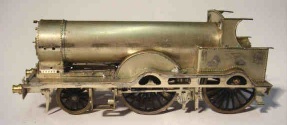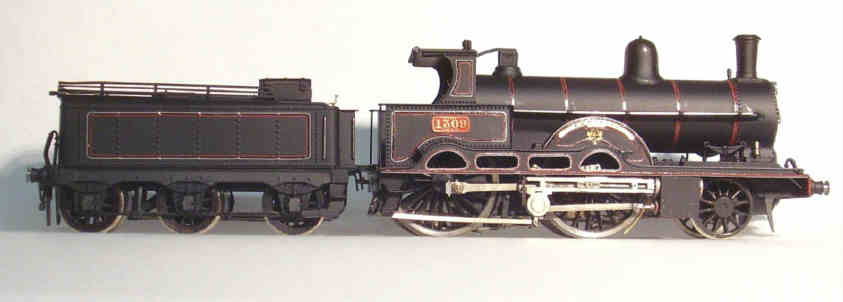'Teutonic' Class, No 1309 "Adriatic"
This model was built from the kit introduced by London Road Models in December 2008. It was designed by Jol Wilkinson, a fellow member of the LNWR Society and a personal friend. As is usual with his kits, it is thoroughly researched and well thought out. A set of Sharman wheels have been produced for use on this model. These are of the correct diameter but the OO version, having over-sized flanges, caused problems with clearances as described later.
The two driving axles on these locos were not coupled together and the kit was designed to be driven only from the rear axle, adhesion being improved by weight being transferred from the tender. I hoped to improve on this scheme by installing two motor and gearbox units, one driving each axle. The motors I chose to use are Hanazono H17's which measure 9.5mm wide x 17mm long x 13mm high and produce 0.7 watts at 17,000 rpm. They are each coupled to High Level "Roadrunner+" gearboxes. The drawing below shows the arrangement of the motors and gearboxes which, after some teething troubles, has proved to be very satisfactory. I can even, by altering a few wires, have the driving wheels going round in opposite directions!
.jpg)
I encountered a few problems whilst assembling this kit. I had to remove some of the rear of the footplate and segments of the boiler to accommodate the Sharman wheels. I made the rear axle fixed and initially intended to spring the front driving axle but this proved to be impractical. I therefore made both driving axles fixed. The leading axle is sprung and can move vertically in slots in the frames. Pickup is taken from all six wheels of the loco. I realised that if I fixed the boiler to the footplate it would be impossible to install the motors so the boiler is a separate assembly that slips horizontally over the motors. The front springs are attached to the boiler unit. The kit includes the parts for the outside Joy's valve gear and suggests that it can be made to work. I like a challenge and I eventually achieved that goal. It is worth the effort to watch it flailing away!
The tender rests on the rear of the loco footplate and on its rear axle. The other two axles run in slots and simply rest on the rails. Pickup is from all six axles of the loco.


Both motors in position in the frames with one wheel still to be installed.
The body with the lid on,
The loco weighs 160grms and the tender 125grms.I have taken readings of its pushing power with and without the tender attached. The results are shown below.
Push with tender attached 35grms. Push with tender detached 30grms. It seems that the weight transfer from the tender is providing useful extra pulling power.
The model made its first public appearances at the Warley and Wigan exhibitions in 2011 and behaved impeccably. It ran smoothly and quietly and the working Joy valve gear did not disintegrate as I feared it might!

The finished loco minus its crew